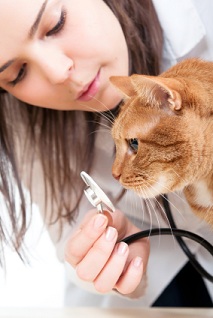Ringworm In Cats
Many people think that ringworm in cats is something to do with real worms, but in fact it is something that is completely different and is actually caused by parasitic organisms that get into the dead outer layers of the skin.
This has become the most common fungal skin infection amongst cats, and if it is left untreated it can affect other animals and humans, and can cause distress and discomfort for your pet.
Ringworm can be contracted in many ways, from unclean bedding and grooming equipment to being exposed to rodents or to other animals or people that have it. There are different form of ringworm, one of which is microsporum, and it is thought that around a fifth of cats may carry this fungus but do not show signs of being infected.

Which Cats are Most at Risk?
Of course, all cats are at risk of getting ringworm based on environmental factors and exposure to the fungus from other things or creatures.
However, there are some cats that are more at risk of getting ringworm than others. Remember, this is something that can be very contagious so can be passed from one animal or human to another.
Young cats under the age of 12 months may not have a fully developed immune system as yet, and could be at increased risk of infection. Cats with diseases that affect their immune systems may also be at increased risk. Stress can make cats more susceptible to a range of health problems, including ringworm, and the condition is more prevalent in long haired cats than short haired ones.
The Symptoms of Ringworm
Circular patches of hair loss are classic symptoms of ringworm, and you will find that these patches are often around the head or limbs. In many cases the hairless patches may appear to be red and sore. You may find patchy areas of baldness anywhere on your cat's body. Another sign of infection can be dandruff in your pet's coat. Infection of the claw and claw bed may also occur as a result of ringworm.
If you do recognise any of these symptoms you need to get your cat treated right away. This is where the fun starts if you have more than one pet, as it means that all of the pets will need to be treated as well as well as the home. Your vet can take samples to confirm that your cat has ringworm, and will then discuss the treatment options with you.
Some Treatment Options for Feline Ringworm
There are a number of treatment options that may be considered for ringworm in cats. If you have a long haired cat you may have to trim off those lovely locks so that the treatment can be administered more effectively, but don't worry, it will grow back.
Shampoos are often prescribed for the treatment of ringworm in cats, and you may have to shampoo the cat every five or six days for a few weeks (be sure to wear your body armour in preparation for the tantrums and struggling!). You should make sure that the cat doesn't lick himself until his coat is dry, as otherwise the ingestion of the shampoo can cause vomiting.
Antifungal drugs are another common solution to treat ringworm, and this can be an oral drug that has side effects, which you should make sure you familiarise yourself with before you start giving the medication.
Home » Cat Health Problems » Ringworm In Cats
Come and join us
We're a thriving community on Facebook, too. Click the Like button below to follow along, then pop on over and say hi.
If this feels like your kind of place, why not bookmark us and visit us again? We'd love to see you. Links to new or updated pages are always included in What's New?
Or, to make sure you never miss out on anything, use the form below to sign up for our newsletter.
Enjoy this? Don't miss out
Sign up for our free newsletter!
Our monthly stroll through items of interest, news and stories, photos, tips, and our cats of the Month.
Don't worry — your e-mail address is totally secure.
I promise to use it only to send you Siamese Cats.
.



